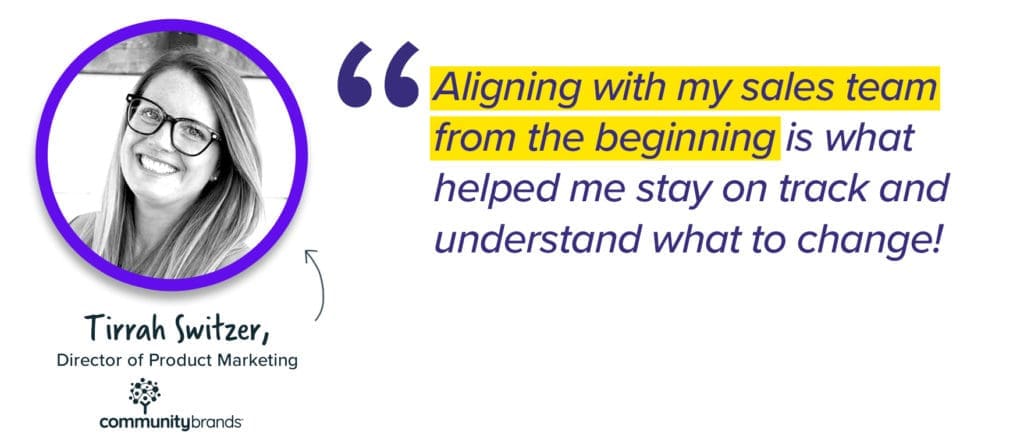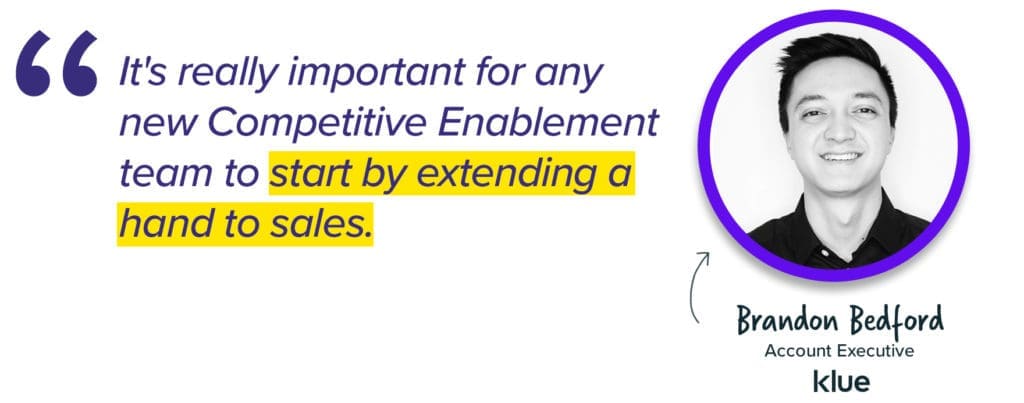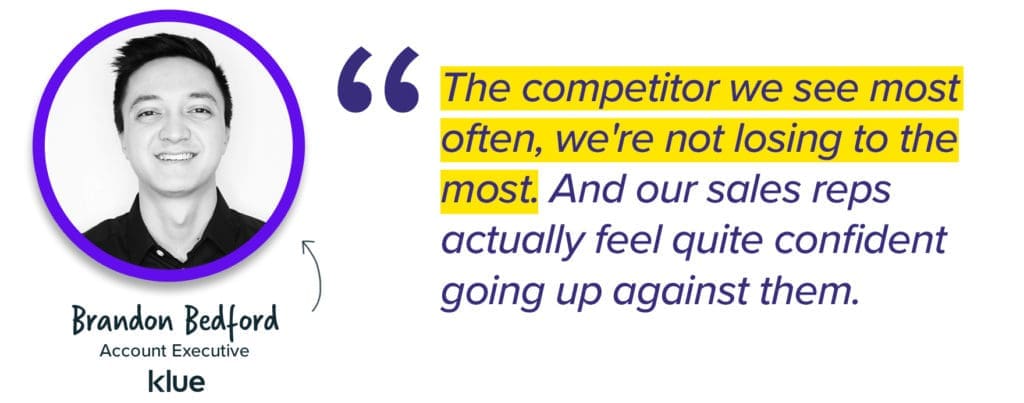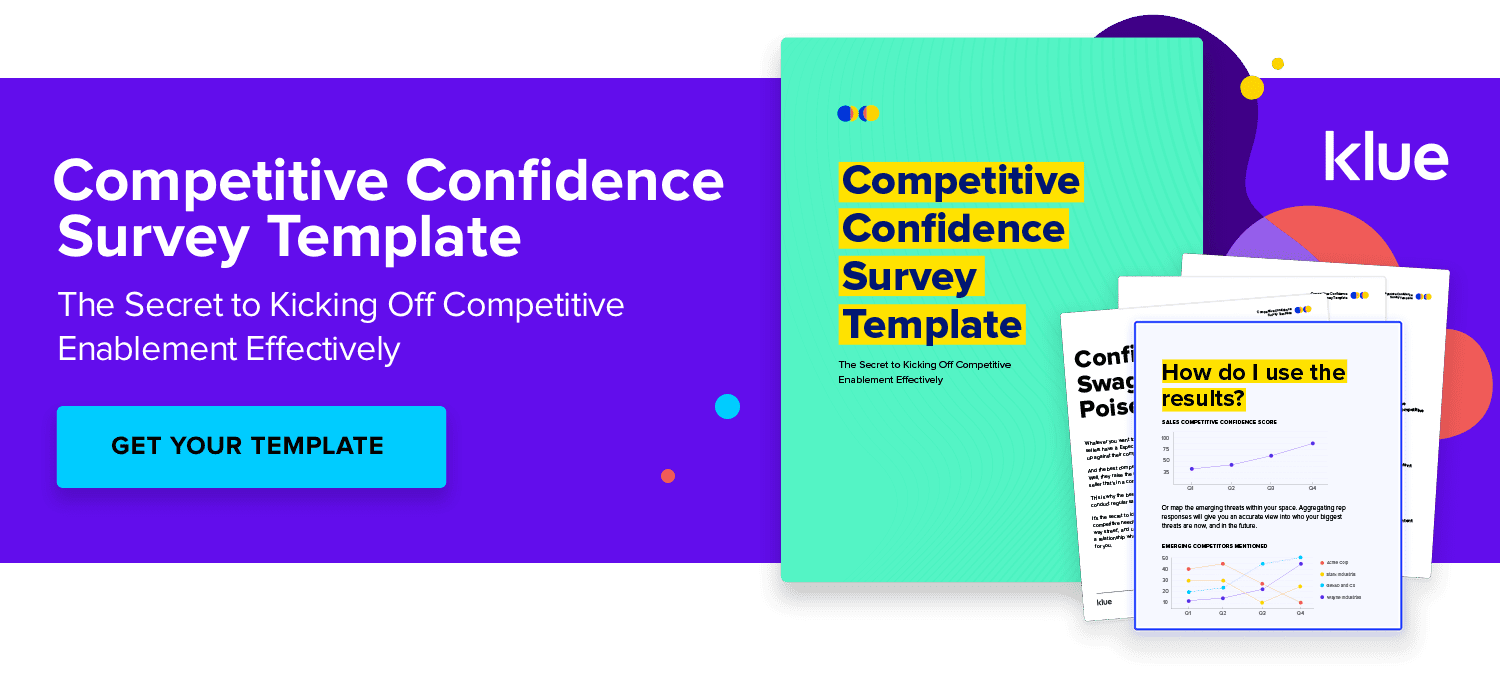Klue Compete
The Competitive Enablement Platform
Learn More
FIND OUT MORE >

What’s the secret to boosting sales confidence in deals against competitors?
Survey says:
Running a competitive confidence survey!
Product Marketing Managers and Competitive Enablement experts have a lot of pain points in common. Near the top of the list is measuring the impact of their competitive program and content.
But by regularly surveying your sellers and measuring their levels of confidence in deals against competitors, and analyzing the results, you can start to form the KPI you wish you had all along.
Here’s a look at why you should run a competitive confidence survey, some of the questions you should ask, and what you can do with the results.


Knowledge plus experience equals confidence. Confidence leads to trust, and trust leads to sales.
That’s how Joseph Curtis, former area VP of Enterprise Sales at Salesforce breaks down the importance of confidence in a 2018 article featured in the Harvard Business Review.
Even without an expert saying it, we all know intuitively that the best salespeople are the most confident ones.
That’s why, as a competitive expert charged with building competitive content to win more deals, understanding the confidence levels of your sellers is paramount.
Asking the right survey questions about how sellers are feeling in deals relative to the competitive content at their disposal will unearth insights into where your program is strong and where it needs improvement.
By running the same survey on a quarterly cadence, you’ll begin to see how changes you have or haven’t made impact seller confidence. And then you can measure the level of confidence against deals won.
But wait, there’s more.
On top of filling gaps in your competitive content, a competitive confidence survey fosters a positive, two-way street, relationship between you and your sellers.
And whether you’re looking to take your competitive program to the next level, or just getting started, your relationship with sales will be crucial to your overall success. In fact, for brand new competitive programs, sales is where you should focus first.


“Building a competitive program without input from sales would be a waste of time,” says Tirrah Switzer, Sr. Director of Product Marketing at Community Brands. “Aligning with my sales team from the beginning is what helped me stay on track and understand what to change along the way.”
Sales is hungry for competitive intelligence and competitive content that will help them win more deals. So you already have an audience demanding the content that only you can produce.
What’s more, tying the value of your program to sales metrics allows you to start quantifying your efforts.
According to Klue’s Competitive Enablement Manager Brandon Bedford, “One purpose [of the survey] is to build trust and respect with the sales team. I think it’s really important for any new Competitive Enablement team is to start by extending that hand to sales and ask them questions like, What do you need? What are the things that I can do to help you?”
If your sellers don’t place trust in your competitive content, they won’t use it.


By seeking advice from sellers in the form of a competitive confidence survey, you’re placing a high value on seller input and feedback.
This engagement with a stated purpose to improve competitive content will be recognized by your sellers and create a virtuous feedback circle of intel and insights.
Landing on the right questions to ask in your survey will depend on the particular insight you’re looking for.
Typically you’ll want to include questions that gauge:
Understanding levels of confidence against specific competitors will help guide you towards focusing your attention in the right areas.
Rare are companies that only come up against one or two competitors in a deal. Much more likely is a reality in which you need to contend with several.
“As a compete team, you have to prioritize where you want to spend your time (…) having questions around which competitors you’re seeing most often will help you get a sense of which competitors you want to focus on,” said Brandon on a recent episode of the Competitive Enablement Show.
Once you’ve determined your desired outcome and crafted a shortlist of questions, you’ll need to turn your attention towards the responses.
The more you can quantify your responses, the easier it will be to analyze the data and make discernible improvements.
As such, the possible responses should always be on at least a 5 point scale.
For example, if the question related to ‘how confident are you against X competitor, the potential answers should be:
Alternatively, you could use an 11-point scale (0-10) for each of your responses. Like they do in the NPS score survey.
The important thing here is that the clearer you make the questions and responses, the easier time you’ll have distilling the findings into action.
The results of your competitive confidence survey will help you immediately understand which competitors need the most attention.
By assessing against which competitors your sellers lack most confidence, you will reveal gaps in content that help you prioritize.
As Brandon found in the first survey he conducted, sometimes it’s not the competitor you suspect that needs the most competitive attention.
“The competitor that we see most often, actually, we’re not losing to the most. And our sales reps actually feel quite confident going up against them. It’s actually competitors that we don’t see as often that we maybe haven’t historically paid as much attention to.”
Whether or not this rings true for your company, measuring the levels of competitive confidence helps you map out your next steps.
For a longer term view, you should be running competitive confidence surveys at a regular cadence. This will allow you to measure changes over time.
How has seller confidence improved against a particular competitor? Against competitors in a particular industry? How have the most common competitors in deals changed?
If you’re conducting regular surveys (at least every year but ideally quarter-over-quarter) sellers’ responses will reveal a higher level look at the competitive landscape that you can bring to your senior leadership teams.


That way you can capture which competitors are posing the biggest threats, and determine what and who to prioritize at the organizational level.
You know the competitive enablement work you do is vital to company.
Sellers that close big deals thanks to your competitive content know the value of your work.
But, as with any nascent function, there will be growing pains before organizations everywhere grasp and implement competitive enablement.
One path to get there is by quantifying the impact you have. Through conducting regular competitive confidence surveys, analyzing the results, and implementing changes, you’ll be one step closer to proving that your competitive content makes a serious difference.
Download our free Competitive Confidence Survey Template to get started.




Competitive Enablement
Product marketers conducting competitive research are drowning in reviews, reports, and messy notes. Here's how Klue's AI foundation will help you complete this analysis in seconds, not weeks.


Competitive Enablement
The topic of Large Language Models (LLMs) has a lot of confusion. Here's what you need to know about how Klue is working with them.


Let’s do it. Tell us a bit about yourself and we’ll set up a time to wow you.
Let's do it. Tell us a bit about yourself and we'll set up a time to wow you.
XLet's do it. Tell us a bit about yourself and we'll set up a time to wow you.
XSubscribe to get our latest AI functionality and news in your inbox.
XOur Buyer Pulse feature, set to launch in Q2 2024, offers valuable insights into the factors influencing buyer decisions in your pipeline. By signing up for the waitlist, we can better gauge interest and proactively engage with you to streamline the setup and integration process before the feature becomes widely available.
X